• Parallel Processing
• Pipelining
• Arithmetic Pipeline
• Instruction Pipeline
• RISC Pipeline
• Vector Processing
• Array Processors
PARALLEL PROCESSING Levels of Parallel Processing - Job or Program level - Task or Procedure level - Inter-Instruction level - Intra-Instruction level
Architectural Classification Number of Data Streams Number of Instruction Streams Single Multiple Single Multiple SISD SIMD MISD MIMD * Flynn's classification - Based on the multiplicity of Instruction Streams and Data Streams - Instruction Stream Sequence of Instructions read from memory - Data Stream Operations performed on the data in the processor
SISD COMPUTER SYSTEMS Control Unit Processor Unit Memory Instruction stream Data stream Characteristics - Standard von Neumann machine - Instructions and data are stored in memory - One operation at a time Limitations Von Neumann bottleneck Maximum speed of the system is limited by the Memory Bandwidth (bits/sec or bytes/sec) - Limitation on Memory Bandwidth - Memory is shared by CPU and I/O
PERFORMANCE IMPROVEMENTS • Multiprogramming • Spooling • Multifunction processor • Pipelining • Exploiting instruction-level parallelism - Superscalar - Superpipelining - VLIW (Very Long Instruction Word)
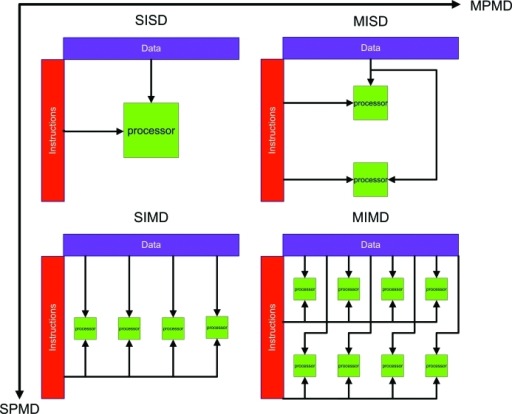
• Pipelining
• Arithmetic Pipeline
• Instruction Pipeline
• RISC Pipeline
• Vector Processing
• Array Processors
PARALLEL PROCESSING Levels of Parallel Processing - Job or Program level - Task or Procedure level - Inter-Instruction level - Intra-Instruction level
Architectural Classification Number of Data Streams Number of Instruction Streams Single Multiple Single Multiple SISD SIMD MISD MIMD * Flynn's classification - Based on the multiplicity of Instruction Streams and Data Streams - Instruction Stream Sequence of Instructions read from memory - Data Stream Operations performed on the data in the processor
SISD COMPUTER SYSTEMS Control Unit Processor Unit Memory Instruction stream Data stream Characteristics - Standard von Neumann machine - Instructions and data are stored in memory - One operation at a time Limitations Von Neumann bottleneck Maximum speed of the system is limited by the Memory Bandwidth (bits/sec or bytes/sec) - Limitation on Memory Bandwidth - Memory is shared by CPU and I/O
PERFORMANCE IMPROVEMENTS • Multiprogramming • Spooling • Multifunction processor • Pipelining • Exploiting instruction-level parallelism - Superscalar - Superpipelining - VLIW (Very Long Instruction Word)

In computing, SISD (single instruction stream, single data stream) is a computer architecture in which a single uni-core processor, executes a single instruction stream, to operate on data stored in a single memory. This corresponds to the von Neumann architecture.
SISD is one of the four main classifications as defined in Flynn's taxonomy. In this system, classifications are based upon the number of concurrent instructions and data streams present in the computer architecture. According to Michael J. Flynn, SISD can have concurrent processing characteristics. Pipelined processors and superscalar processors are common examples found in most modern SISD computers.
Single instruction stream, multiple data streams (SIMD)
A computer which exploits multiple data streams against a single stream to perform operations which may be naturally parallelized. For example, an array processor or graphics processing unit (GPU)
Multiple instruction streams, single data stream (MISD)
Multiple instructions operate on one data stream. This is an uncommon architecture which is generally used for fault tolerance. Heterogeneous systems operate on the same data stream and must agree on the result. Examples include the Space Shuttle flight control computer.
Multiple instruction streams, multiple data streams (MIMD)
Multiple autonomous processors simultaneously executing different instructions on different data. MIMD architectures include multi-core superscalar processors, and distributed systems, using either one shared memory space or a distributed memory space.
Single instruction, multiple threads (SIMT)
Single instruction, multiple threads (SIMT) is an execution model used in parallel computing where single instruction, multiple data (SIMD) is combined with multithreading. This is not originally part of Flynn's taxonomy but a proposed addition.
Diagram comparing classifications
These four architectures are shown below visually. Each processing unit (PU) is shown for a uni-core or multi-core computer:
- Pipelining Design Techniques
- Pipelining refers to the technique in which a given task is divided into a number of subtasks that need to be performed in sequence.
- • Each subtask is performed by a given functional unit.
- • The units are connected in a serial fashion and all of them operate simultaneously.
- • The use of Pipelining improves the performance as compared to the traditional sequential execution of tasks.
- Three performance measures for the goodness of a pipeline are provided: – Speed-up S(n), – Throughput U(n), and – Efficiency E(n).
- • It is assumed that the unit time T = t units.
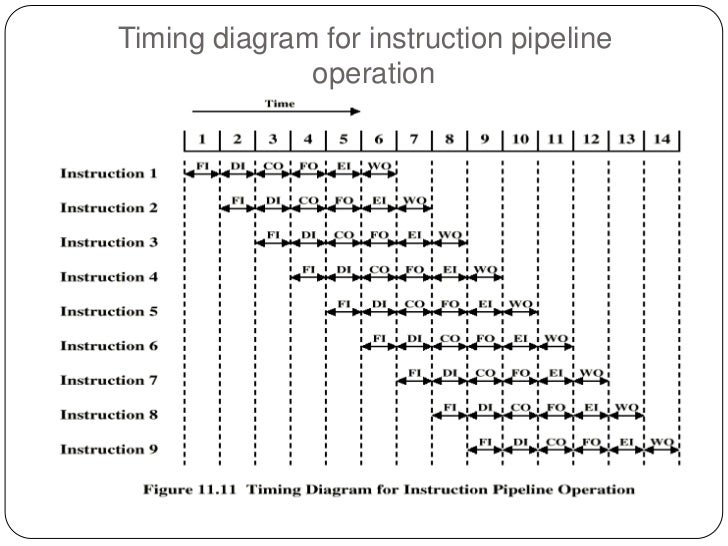

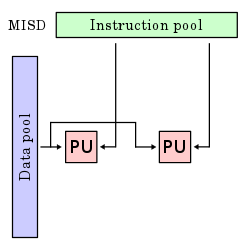
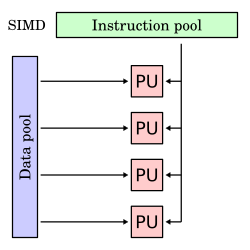
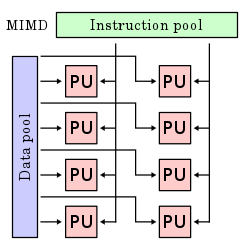

No comments:
Post a Comment